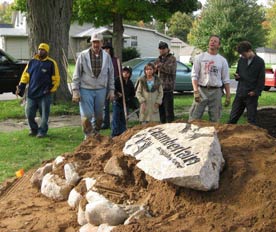ESOP Ascendant
It’s fall 2009, and times are good for troublemakers. Seifert’s office, now one of many around the state, is filled with dedicated and loyal staff members who enjoy warmhearted jokes at his expense. Why has foreclosure changed ESOP’s fortunes?
Foreclosure is the most pressing problem facing the city and extends far beyond the individual homeowners and their lenders to include whole neighborhoods affected by declining value and quality of life, ruining the tax base of the city and resulting in significant policing problems. And yet, while community developers work to stabilize physically deteriorating neighborhoods, they have neither tools nor tactics to deal with the problem of people being thrown out of their homes in the first place. Foreclosure has overwhelmed the community development system. While most CDCs look as though they will survive, it’s often only because of a coordinated intervention effort to save them.
On the other hand, despite being ostracized for a decade, ESOP can deliver the goods. ESOP, in its role as foreclosure counselor, can boast a loan workout success rate of over 80 percent (federal programs have a failure rate of over 80 percent). Why is ESOP successful where so many others routinely fail?
“It’s not that we’re good negotiators. We’re good shark throwers,” Seifert says, describing the “hits” where he, his staff, and those he organizes express an “abundance of good-natured anger at lenders and banks.” He points to the little plastic sharks that find their way into the shrubs surrounding the homes of bank officials and onto the desks that occupy bank offices.
Of course you also have to know how to fix the loan — something that ESOP has also become expert at. But, as far as Seifert is concerned, that isn’t very hard. ESOP, like countless other organizations that engage in “foreclosure counseling,” is primarily in the business of talking on the phone with bank representatives on behalf of their clients in order to secure loan workouts that keep people in their homes. When servicers and investors aren’t willing to renegotiate terms, ESOP has relationships with local community banks that will refinance a mortgage, often with the original lender eating some of the principal. ESOP identifies problem lenders and invites them to come and negotiate a general memorandum of understanding concerning negotiations over foreclosure workouts.
The costs of foreclosure are so high, especially in a declining and impoverished city, that even for servicers and lenders it is usually more cost-effective to keep borrowers in their home. The high-cost/low-return nature of foreclosure, especially in Cuyahoga County, has prompted some servicers to see the issue as Seifert does. Servicers like Ocwen and Litton came to the table with little fuss. Others (Citibank, JP Morgan Chase, Countrywide) have more difficulty seeing things the way ESOP does.
The difference with ESOP’s approach is that, unlike with most others doing this work, when it reaches an impasse, the buses will be ordered and the sharks stockpiled. The problem, Seifert says, is that servicers and lenders often need to have their minds focused on the issue. “Hitting” them is a useful way to do that, but Seifert gets frustrated with the banks’ recalcitrant behavior. After all, the workouts ESOP negotiates haven’t cost the lenders “a dime.”
The carrot in ESOP’s toolbox is a realistic and respectful approach to the workouts. Seifert says, “They know that we will never go to the wall and say ‘you must fix this loan.’ We don’t help someone with an income of $100 a month stay in their home. They have to sell.” Indeed, ESOP is now regarded by some lenders as an essential bridge to a borrower population that doesn’t trust them and doesn’t want to deal with them. In 2007, Ocwen provided ESOP with a list of borrowers who had adjustable rate mortgages that were going to reset over the next 12 months. ESOP contacted the borrowers, let them know their mortgage rate was about to double, and helped those interested secure workouts, nipping a looming problem in the bud.
This success has changed the perception of the organization. Seifert is now consulted on foreclosure prevention and even partners with CDCs and intermediaries. Lenders trust ESOP and often turn to it to help them dispose of unwanted properties; ESOP ensures they are disposed of responsibly by community developers and, in doing so, has become a mediator not just between lenders and borrowers, but between lenders and the very community developers who spent decades building friendly partnerships with those lenders by putting them on boards. Seifert’s relationship with them is stronger because he has won cooperative relationships through the respect and recognition that comes from successfully negotiating an outcome to a confrontation — something that can never be achieved when confrontation is off the table.
“We’re desperately trying to create this image that sometimes throwing a shark makes sense and that it should be viewed as mainstream,” says Seifert. “The reality is that we don’t throw sharks at people just for the hell of it.”
But ESOP hasn’t yet succeeding in having the value of its organizing recognized by funders. While it has been capturing an increasing percentage of government funds for foreclosure counseling, other organizations have captured grant funds from banks that don’t want to deal with ESOP. After hearing about a competitor that received $2 million, Seifert offers that he could solve the predatory lending problem in Cleveland with that much money. How? “I would hire 20 organizers and beat the shit out of the banks.”






Comments